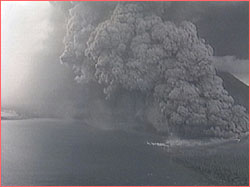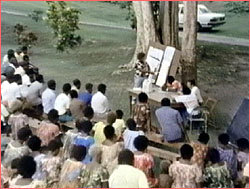
|
 |
 |
In September 1994, Rabaul volcano on the Papua New
Guinean island of New Britain erupted. "The death toll
could have been many thousands, because about 75 percent
of the houses collapsed," said Dr. Stanley Williams, a
volcanologist at Arizona State University who visited the
site shortly after the blast. As it turned out, only a
handful of people died.
There are two reasons for this stunning success. First,
in the hours leading up the eruption, observant elders
who had survived a 1937 eruption of Rabaul
noticed—and acted upon—several strange
occurrences that had also preceded that long-ago blast.
According to Ben Talai, assistant director of the Rabaul
Volcano Observatory, these included the ground shaking
vertically rather than horizontally (as it had done
periodically since 1983); megapod birds suddenly
abandoning their nests at the base of the volcano; dogs
barking continuously and scratching and sniffing the
earth; and sea snakes crawling ashore.
Second, residents followed a carefully designed
evacuation plan.
Below are the dramatic particulars of the Rabaul
evacuation, as related in "Reducing Volcanic Risk," a
1997 video produced by the International Association of
Volcanology and Chemistry of the Earth's Interior
(IAVCEI) and the United Nations Educational Scientific
and Cultural Organization (UNESCO). As Stan Williams
noted, the evacuation was "a wonderful example of how
people can be educated to save themselves."
The city of Rabaul and its harbor are located in the middle of an enormous volcanic crater. Just before and during World War II, explosive eruptions built [a large] cone along the harbor and caused a series of ash flows, tsunamis, and extremely heavy ash fall. The eruptions killed 500 people. Beginning in 1983, the volcano threatened to erupt again. Scientists monitoring Rabaul's crater detected a dramatic increase in earthquake activity that continued for the next 11 years. Tens of thousands of earthquakes rattled the harbor. Scientists also detected other changes caused by magma moving below. Parts of the bay were pushed up by more than a yard. Even so, no eruption took place. But the volcano's warning signs were enough for the people of Rabaul to put into place the three components of an emergency plan:
While the city was severely damaged by ash fall in the coming weeks, only three people died during the evacuation—a tribute to the emergency plan that was prepared and practiced a decade earlier.
Are you and your community ready for a volcanic eruption? Do you know which areas will be dangerous during the next eruption? Do you have an emergency plan? And when faced with scientific uncertainty as to the size and timing of an eruption, are you willing to err on the side of safety and accept the possibility of false alarms? The ultimate test of your emergency preparation is a real eruption. The time to reduce your volcanic risk is now, before your volcano threatens to erupt. And then, when your volcano rumbles back to life, don't hesitate to use your emergency plan.
Planning for Disaster | Resources | Teacher's Guide Transcript | Printable page | Site Map | Vesuvius Home Editor's Picks | Previous Sites | Join Us/E-mail | TV/Web Schedule About NOVA | Teachers | Site Map | Shop | Jobs | Search | To print PBS Online | NOVA Online | WGBH © | Updated November 2000 |
 The eruption of Rabaul, Papua New Guinea, September,
1994.
The eruption of Rabaul, Papua New Guinea, September,
1994. Educating the people of Rabaul about the evacuation
plan.
Educating the people of Rabaul about the evacuation
plan.
 Evacuation of Rabaul.
Evacuation of Rabaul.